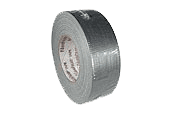Duct Tape
Duct tape is a polyethylene, reinforced, multi-purpose pressure sensitive tape with a soft and flexible shell and pressure sensitive adhesive. It is generally silver or black in color but many other colors have recently become available. With a standard width of 1 7⁄8 inches (48 mm), duct tape was originally developed during World War II in 1942 as a water resistant sealing tape for ammunition cases. Permacel, then a division of Johnson & Johnson, used a rubber-based adhesive to help the tape resist water and a fabric backing to add strength. It was also used to repair military equipment quickly, including jeeps, firearms, and aircraft because of these properties.
In military circles, this variant is known as "gun-tape", typically olive-green, and also known for its resistance to oils and greases. It is also called "Duck Tape", "Riggers Tape", "Hurricane Tape", or "100-mph tape"—a name that comes from the use of a specific variety of duct tape that was supposed to hold up to 100 mph winds.[citation needed] Another version attributes this to the fact that soldiers often refer to something that exceeds expectations as "High Speed."
Contents
Common uses
Duct tape is commonly used in situations that require a strong, flexible, long lasting adhesive, particularly when exposure to the elements is a concern.
A more specialized product, commonly known as gaffer tape, is preferred in entertainment circles, as it does not leave a sticky residue when removed, comes in matte black, and is more easily torn into thin strips for precise application.
Duct tape, in its guise as "racer's tape", has been used in motorsports for more than 40 years to repair fiberglass bodywork. Racer's tape comes in a wide range of colors to help match it to common paint colors.[1] In the UK it is usually referred to as "tank tape" in motorsports use.[2]
Usage on ductwork
To provide lab data about which sealants and tapes last, and which are likely to fail, research was conducted at Lawrence Berkeley National Laboratory Environmental Energy Technologies Division. Their major conclusion was that one should not use duct tape to seal ducts (specialty tapes are available for this purpose). (They defined duct tape as any fabric-based tape with rubber adhesive.) The testing done shows that under challenging but realistic conditions, duct tapes become brittle and may fail.[3] Commonly duct tape carries no safety certifications such as UL or Proposition 65, which means the tape can violently burn, produce toxic smoke, ingestion and contact toxicity, irregular mechanical strength, and low life expectancy for the adhesive on the tape. Its use in ducts has been prohibited by the state of California[4] and by building codes in most other places in the U.S. However, metalized and aluminum tapes used by professionals are still often called "duck/duct tapes".
Strength
In "Mythbusters ep 8e07 Duct tape hour 2" the breaking strength of duct tape is measured to 67.3 pound of force. (That was tested by simply hanging under a stip of it with a force gage.
Etymology
The origin of the name of the product, "duck tape" or "duct tape", is the subject of some disagreement.
One view [5] is that it was called "duck tape" by World War II soldiers either because it resembled strips of cotton duck or because the waterproof quality of the tape contributed to the name, by analogy to the water-shedding quality of a duck's plumage. Under this view, soldiers returning home from the war found uses for duck tape around the house, where tents were forgotten and ductwork needed sealing, not ammunition cases. Other proponents of this view point to older references to non-adhesive cotton duck tape used in Venetian blinds, suggesting that the name was carried over to the adhesive product. The Oxford English Dictionary says that perhaps "duct tape" was originally "duck tape". This view is summarized most notably in a New York Times article by etymologist William Safire in March 2003. Safire cites use of the term "cotton duck tape" in a 1945 advertisement for surplus government property.[6] The Oxford English Dictionary gives a 1902 quotation for "100,000 yards of cotton duck tape" being used to protect the cables of the Brooklyn Bridge.[7] Thus a fabric duck tape was available to which an adhesive could have been added.
In any case, whether it is an error or a preservation of the original usage, the term "duct tape" is used for the product today.[8] Duck Tape is also a brand name for this product in some countries.
Notes and references
Cite error: Invalid <references> tag;
parameter "group" is allowed only.
<references />, or <references group="..." />External links
- Etymology provided by Jan Freeman, Boston Globe (reproduced)
- Duct Sealant Longevity
- Duct tape not good for ducts from the California Energy Commission
- http://www.octanecreative.com/ducttape/duckvsduct.html
